Editorial
Please also take a look at the article by Hugh Cory Critical Thinking, Simon Says, for Burma in this issue of HLT.
Bewitched by 25 Students
Agnese Bartoli, Italy
Agnese Bartoli is a teacher in Rome, where she teaches in a public middle school. She has been teaching to Burmese migrant children on the Thai/Burmese border for a few months, she has worked as a volunteer for an Italian NGO (www.helpwithoutfrontiers.org). She also trained students at the KTTC (Karen Teacher Training College). E-mail:agnesebar@gmail.com
Menu
About the article
Background
Description of activities
Short stories
Dialogues
Descriptions
Final note
In July Hugh Cory sent you 2 articles, one of which was mine. I've been collaborating with Hugh this year, teaching English on the Thai/Burmese border. After Hugh Cory passed away, it took me a while to decide what to do of this article of mine. He encouraged me in writing it so, after revising it, I decided to send it to HLT. ( from Agnes’ e-mail to HLT editor)
At the beginning of 2008 I spent 3 months in Mae Sot, on the Thai/Burmese border, and I’d like to share the story of these three months at Kwe Kha Baung School for Migrant Karen students. When I first visited the school I was shocked. One enters from a tiny street level restaurant and in the back there is the kitchen, which actually consists of only a big free standing propane gas tank on the floor; all the cooking, at both the school and the restaurant, happens on this big flame. Narrow dark stairs lead to the upper levels: the computer room, the classrooms (which are used as bedrooms at night), the assembly room: one on top of the other. My first day of school when I arrived, it took me almost 20 minutes to figure out where my classroom was … I had to ask several times before I could finally reach the right spot.
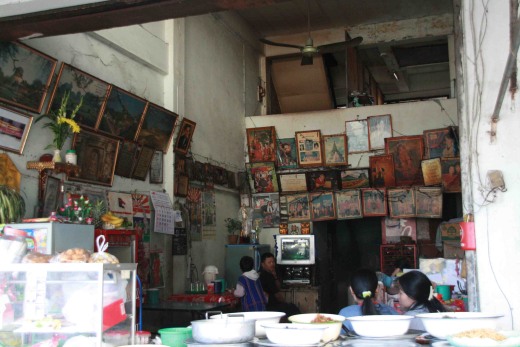
school entrance
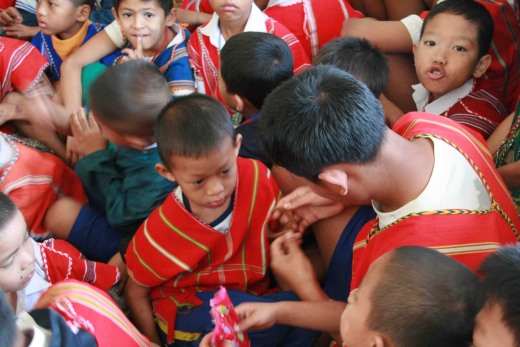
assembly time
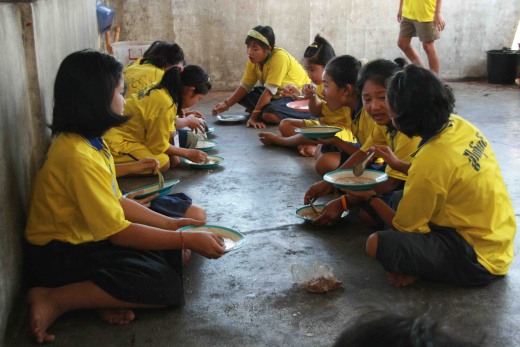
canteen
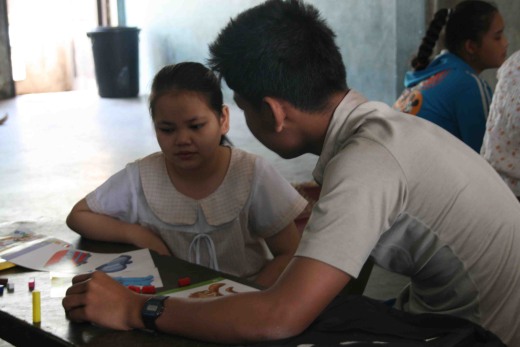
flash cards and rods
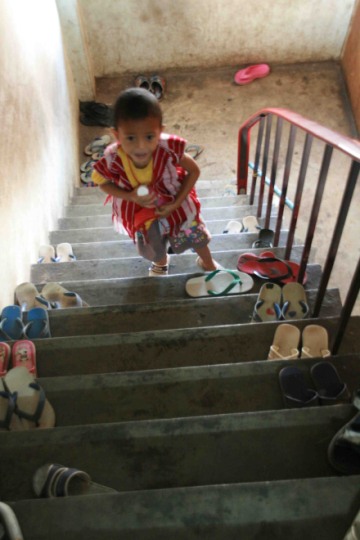
going to class
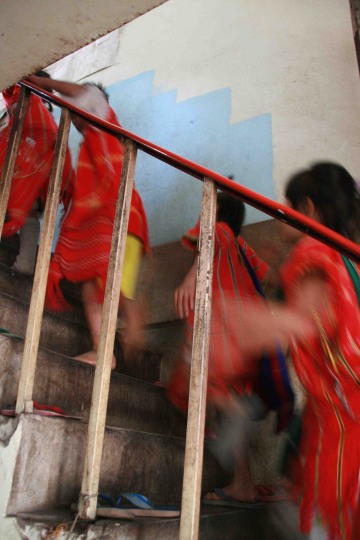
going to class

kitchen
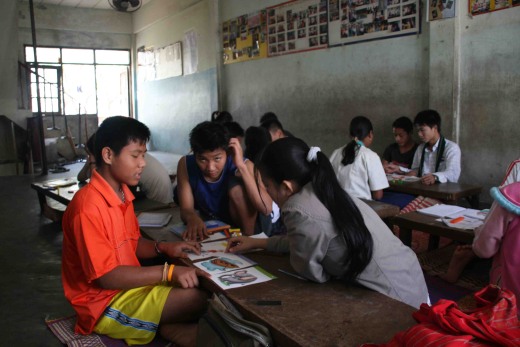
lesson
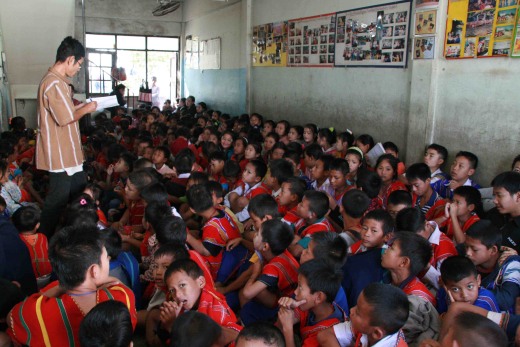
morning assembly

school bus
When the students saw me (as there was no room to enter!) I was welcomed with a “Good morning teacher” but I wasn’t prepared for the “Goodbye teacher, THANK YOU teacher” when the bell rang at the end of the lesson: I’ve never been thanked for teaching anyone!
The first, and maybe the most difficult task, was to learn as soon as possible all the names of the students: it was very hard to remember them and to pronounce them correctly. It took me almost a week to be able to call the majority of them by their name.
I found out that, although the students have been reading very hard passages from their textbook and making exercises, they couldn’t understand even very simple questions and had no idea of how to speak English. A basic conversation was out of question and if I couldn’t understand them they would start spelling out the words for me, at such a speed I could hardly follow. Afterwards I understood why: 90% of the teaching has been mostly on a spelling, memorizing and repeating by heart basis.
So my main effort in these 3 months has been to create situations to improve the students’ oral skills through a series of different activities.
After a while I realized the students, even the young ones, didn’t notice my presence at school: it was normal for me to be there. I felt this was a great success: I could go to visit any time and they would not think it was inappropriate, they just thought I was part of the big family. English has become a language of communication and they used it naturally with me, with a lot of effort and their mistakes that allowed them to learn.
It was one of the most touching and fulfilling experiences of my life. They have my heart.
I eventually organized a farewell party at the lake, to give them the chance to get out of Mae Sot. These people are never allowed to go anywhere, they almost live under house arrest, and for teenagers this is particularly hard. So I took them to the reservoir to swim, to have a good meal at the restaurant, to sing and dance in the darkness of the night. To feel free, for once.
I basically decided to focus on 4 kinds of production: description, short stories, asking questions and dialogues. Obviously all of them mix in one another, and it is important to master them in order to produce a consistent piece of language. I had 3 months time to try my best.
One main problem was to get the students break the scheme of teacher focused lessons. I slowly made them work in pairs, in random groups of 3, change the arrangement of the classroom. It took a little bit but after a few lessons they quickly learnt to change the arrangement of the desks according to the activity that was going on. They were enthusiastic of this new way of learning, therefore they were keen to help and ready to change their attitude.
The major aim of my teaching was to get the students produce language in a given context but in a free way, to give them a frame work to make it easier for them to move, but to move freely as they pleased. I therefore organized some activities, using specific tools, such as:
Create:
- short stories (using rods, comics and flash cards)
- dialogues (using rods and comics)
- descriptions (using flash cards and pictures)
I had to take care of 3 standards (8th, 9th and 10th) for a total of 25 students (13/18 years old) for 3 hours a week for each standard and 2 hours on Sat and Sun for special lesson (all the 25 students together).
I wanted to first give them examples to have a clear reference and sample, and then let them move freely. So I basically followed the patterns outlined below.
- Reading a very short and simple story (3-4 lines)
- Read it silently on their own
- Discuss with friends to understand it; if necessary ask the teacher for help
- Listen to the teacher reading it, paying attention to pronunciation and pauses (marking them with a pencil)
- Try to read it aloud with the friends’ help
- Asking questions on the story
- Write the questions
- Retell the story and/or continue it
- Create a story with comics (the last picture can be left out in order to have open ends)
- Look at the pictures
- Go through the basic vocabulary needed, given by the teacher
- Create a story
- Individually
- In small group
- The whole class with the teacher’s guide
- Tell the story (to the group, to the teacher, to the class)
- Listen to the other stories and helping the others to improve
- Write the story (individually or in group) taking into account all the good suggestions
- Write the questions on the story
- Answer to somebody else questions
- Create a story using rods with given elements and/or title
- In small random groups of 3 (or individually) the students create a story, using as many rods as they need
- Tell the story to the others
- Listen and help the other to improve
- Write the story taking into account the good suggestions
- Write questions on the story
- Listening to a dialogue
- Usual procedure for listening activities
- Listen and write it; then compare with group’s friends to check and understand it
- Learn it by heart paying attention to prosody (if possible listening to the original)
- Dramatize it with friends
- Create a dialogue with comics (same procedure as for the story, but the dialogue is not read but dramatized)
- Create a dialogue using rods (same procedure as for the story, but the dialogue is not read but dramatized)
- Listening to a description
- Listen to the teacher reading a simple description (3 times)
- Draw according to the description
- Ask the teacher for difficult words or sentences
- Compare with friends
- Rewrite the description
- Ask questions
- Answer somebody else description
- Making a description of a flash card or a picture
- In random groups of 3 (or individually) the students describe the flash cards(or picture)
- Ask the teacher for difficult and needed vocabulary
- Listen to everybody’s description
- Write the description taking into account the best suggestions
The teacher’s role was to help the students when needed, give ideas if requested, solve the relationships problems, give vocabulary if needed, co-ordinate the groups’ and classroom work, write on the blackboard to focus on the important pieces of language, ask to make clear when there was a serious lack of communication.
I usually gave exact time for each part of the activity to be carried out.
I organized the lesson in order to give a balanced mix of all the activities described, taking into account also the vocabulary to be used (at the shop, at the restaurant, at home, etc.).

Please check the Methodology and Language for Primary Teachers course at Pilgrims website.


|